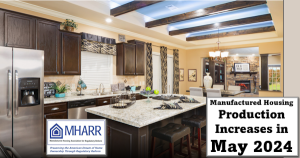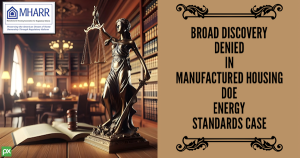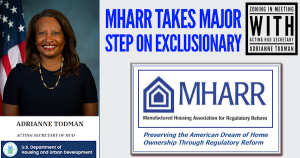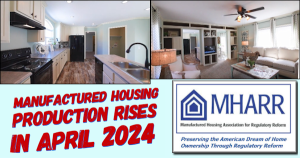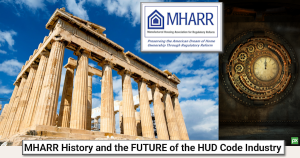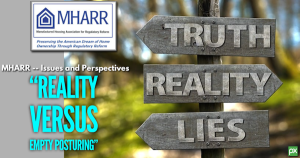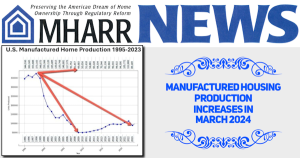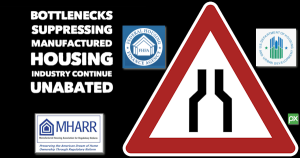Washington, D.C. Updates on Manufactured Housing Issues Including – DOE Energy Assault, HUD Moving on DOE Standards, MH Financing, MH White Paper and More
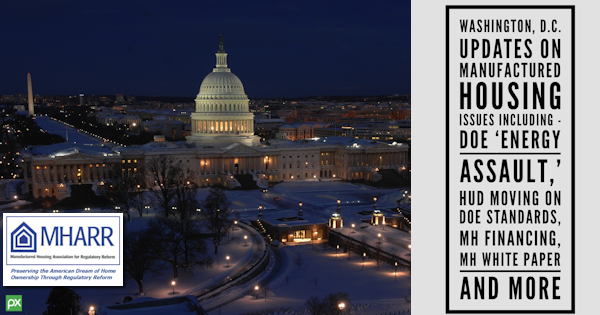
IN THIS REPORT: SEPTEMBER 28, 2022
- DOE “ENERGY” ASSAULT ON MH COMES TO A HEAD
- HUD ALREADY MOVING ON ENERGY STANDARDS
- MHARR COMMENTS ON LATEST HUD PROPOSED STANDARDS
- MHARR CALLS FOR END TO GINNIE MAE “10-10” RULE
- MHARR WARNS FHFA ON DTS CHARADE
- MHARR WHITE PAPER VALIDATED YET AGAIN
INDUSTRY FALLING BEHIND ON DISCRIMINATORY DOE “ENERGY” MANDATE
The fifteen-year battle over U.S. Department of Energy (DOE) “energy conservation” standards for HUD Code manufactured homes has reached a decisive point, as DOE recently published its final standards with full implementation scheduled for May 31, 2023. These standards, if not stopped and substantially modified, will be a disaster for the manufactured housing industry and consumers already facing an extreme and growing shortage of affordable housing.
As a result, the industry and other stakeholders have less than a year (and, in reality, eight months, with the clock running) to take action to stop the DOE standards – which, as explained below, is do-able — and send the DOE process back to the drawing board. Absent that, the destructive and discriminatory DOE standards will become a fait accompli, with further high-cost mandates being pushed forward on a regular basis, as energy and climate special interests push the International Energy Conservation Code (IECC) – the statutory benchmark for the DOE standards – to their ultimate goal of “net-zero” energy use. And, in reality, there likely is only one way that the DOE standard can be stopped before it does severe harm to both the industry and consumers.
The Manufactured Housing Institute (MHI) – which made a crucial error in initially supporting the DOE rulemaking process – has promoted legislation that would require DOE, among other things, to “fully consult with HUD” and require any DOE energy standards to be “adopted by HUD as part of the HUD Code.” While such legislation might have been useful at a much earlier stage, when MHI could have worked with MHARR (as it did on the Manufactured Housing Improvement Act of 2000) to ensure legitimate and cost-effective standards, MHI’s continuing delay in seeking such relief has allowed DOE and energy/climate special interests to gain the upper hand.
Right now, legislative action is a non-starter, as it is highly unlikely that any effective remedy would succeed today, or in the near-term. Both the Biden Administration and the current majorities in Congress have made it clear that “climate change” and related energy consumption policies are among their highest priorities. This perspective will not change before the November 2022 midterm election and the seating of a new Congress in 2023. Therefore, any chance of enacting legislation or eliciting Executive Branch relief for the impending energy standards, at present, is virtually nil. After going to the effort to produce final standards under 15-year-old enabling legislation and a court-ordered deadline, and with energy and “climate change” activists poised to fight any implementation hiccup, neither the current Congress nor the current Administration is going to adopt legislation or support any remedy that would alter the status quo.
Nor does the picture improve significantly even if the 2022 midterm election produces a change in control of one or both houses of Congress as some prognosticators suggest. A change in control of the House of Representatives, but not the Senate, would leave any remedial legislation in limbo. A change in control of both houses could conceivably lead to some type of relief legislation, but a presidential veto would be a virtual certainty. And, with a closely divided Senate (the likely outcome under any scenario) a veto override requiring a 2/3 majority would be a non-starter. Consequently, the prospect of relief legislation becoming law prior to implementation of the DOE standards would be minimal, with virtually no possibility of Executive Branch relief.
Consequently, the best prospect for timely relief from the DOE rule continues to be in the courts. And while an industry court action has its own challenges, including cost, unpredictability and no guarantee of success, it is, at least:
(1) a forum that is available now;
(2) which has the ability to act prior to the scheduled DOE implementation date;
(3) that could force either a “re-do” of the DOE rule or, at a minimum, set back the implementation timeline to a point when the prospect of obtaining either legislative or Executive Branch relief would be greater.
By contrast, a failure to act now to thwart the DOE rule would not only allow that rule to devastate the HUD Code market in the near-term, but also allow it to become the baseline for a non-stop parade of ever-more stringent and costly IECC-based energy standards for HUD Code homes under section 413(b)(3) of the Energy Independence and Security Act of 2007 (EISA), as the IECC is updated every three years.
Industry legal action to seek an injunction against the DOE standard could focus on any number of fatal errors in the DOE rulemaking process, as were examined in greater detail in the August 2022 “MHARR — Issues and Perspectives” article. These dispositive errors include, but are not limited to:
(1) DOE’s failure to quantify the full cost impact of its manufactured housing energy standards by omitting any consideration or analysis of testing, enforcement and compliance costs;
(2) DOE’s failure to consider other significant costs, including, among other things, the exclusion of millions of potential purchasers from the HUD Code market due to excessive regulation-driven purchase price increases, and the price impacts of regulatory unpredictability flowing from: (i) ongoing IECC code changes; and/or (ii) arbitrary and capricious DOE changes and modifications to IECC criteria based on its alleged “discretion” to alter those requirements;
(3) DOE’s failure to analyze and consider the full cost of its rule by materially underestimating the severity and impact of inflation;
(4) DOE’s fraudulent and arguably corrupt procedure for the development of both its proposed and final standards; and
(5) DOE’s failure to comply with EISA section 413 by failing to consult with HUD and the MHCC in a meaningful way at the beginning of the standards-development process, when such consultation might have had a beneficial impact in ensuring the consistency of DOE’s standards with the unique construction and role of manufactured housing as a key source of affordable homeownership.
Again, these are just some of the claims that could be asserted against the DOE final rule in an appropriate court action organized and supported by the entire industry. There are many others as documented by MHARR, including use and citation of the Social Cost of Carbon (SCC) metric, even though DOE disingenuously denies any reliance on that guesswork masquerading as “science.”
Nothing will change, though, without an industry court challenge to invalidate and obtain an injunction against the enforcement of the DOE final standard. This challenge should be organized by MHI as the self-identified representative of “all segments” of the manufactured housing industry, and should be supported by all other industry organizations and those who earn their living within the HUD Code industry. MHI has the means, resources and structures to organize such a lawsuit and it is – and should be – incumbent on that group to do so before the end of 2022. Four months of valuable time have already been wasted. There is no basis or excuse for further delay and MHARR pledges its cooperation with — and support for — such a lawsuit.
HUD/DOE ENERGY COLLUSION WARRANTS RAPID INDUSTRY LEGAL ACTION
The urgent need for decisive and effective industry legal action to stop the DOE “energy” standards was further underscored on September 21, 2022, when HUD published notice of two impending Manufactured Housing Consensus Committee (MHCC) meetings. According to HUD’s Federal Register notice, those meetings, in October and November 2022, are being scheduled because “the Department of Energy’s Energy Conservation Standards for Manufactured Housing, which have a compliance date of May 31, 2023, do not fully align with the current Manufactured Housing Construction and Safety Standards.” Based on this premise, the notice states: “Given that manufacturers have to comply with the Department of Energy’s Energy Conservation Standards for Manufactured Housing and the MHCSS, and HUD’s role in regulating the manufactured housing industry, HUD considers it imperative to promptly proceed with rulemaking to align the MHCSS with the Department of Energy’s Energy Conservation Standards for Manufactured Housing. To this end, HUD is scheduling two sets of meetings of the MHCC to allow discussion, analysis, and recommendation to HUD of such alignment.”
Thus, while HUD and DOE effectively ignored and bypassed the MHCC in developing manufactured housing energy standards, not involving the MHCC from the start in either the organic development of those standards or the crucial task of adapting and modifying IECC criteria for use, exclusion or modification within the unique context of manufactured housing, they are now – as an afterthought – seeking to force this matter through the MHCC as rapidly as possible in order to saddle consumers and the industry with baseless, yet market-killing regulation. Put differently HUD, rather than working with the industry to stop the egregious and destructive DOE standards, which will significantly and needlessly increase the cost of manufactured housing; exclude millions of lower-income consumers from the HUD Code market and place homeownership beyond the reach of millions more lower and moderate-income American families, is instead seeking to expedite the implementation of those standards, to the ultimate detriment of both consumers and the industry – something that is and should be a serious concern given the less than stellar history of the program. Meanwhile, as this process is moving forward at – what is for the federal government – a breakneck pace, MHI and the broader industry have wasted four months since the publication of the final DOE standard without taking effective action to stop the DOE rule.
HUD’s action to move forward rapidly with the implementation of the egregious, high-cost DOE standards (presumably under its own enforcement system, including Subpart I) shows that the Department, rather than acting to protect, defend and advance the industry and its consumers under federal manufactured housing law, is instead colluding with the energy ideologues and climate extremists at DOE to foist the Administration’s “climate change” agenda on the backs of those Americans who can least afford it. All of this underscores again, the need for immediate and decisive industry legal action to seek an injunction against the DOE standards and their destructive enforcement in just a few short months.
HUD PROPOSAL EXPOSES DANGER OF NEEDLESS SPRINKLER “STANDARD”
In written comments recently filed with HUD, MHARR has, once again, strongly opposed the adoption of a proposed “voluntary” or conditional fire sprinkler standard for manufactured homes. Those comments, submitted on August 22, 2022, and provided to the broader industry, continue MHARR’s longstanding policy of: (1) objecting to the incorporation of any discriminatory fire sprinkler standard (either mandatory or conditional) in the HUD Code; and (2) calling for the federal preemption of discriminatory state and/or local fire sprinkler standards based on the existing fire safety provisions of the HUD Code, which ensure reasonable fire safety for manufactured home residents without costly (and in some cases impracticable) sprinklers. MHI, by contrast, concedes HUD’s failure to “broadly and liberally” construe federal preemption to invalidate state and local sprinkler standards in its written comments, while it “acknowledges the need for the conditional [HUD sprinkler] standard.”
MHARR maintains in its comments, as it has consistently, that the existing HUD “Fire Safety” standards – without a sprinkler mandate or any other sprinkler provision – already provide reasonable “fire safety” for manufactured housing occupants, as required by federal law. “Manufactured housing safety” is defined by federal law as “the performance of a manufactured home in such a manner that the public is protected against … any unreasonable risk of death or injury to the user” of the home. The necessary prerequisite to the adoption of any federal manufactured home safety standard, therefore, is the existence of an “unreasonable risk” of death or injury to the occupant(s) of a manufactured home.
But no such risk exists in the case of fire or fire sprinklers. According to a July 2011 National Fire Protection Association (NFPA) report entitled “Manufactured Home Fires” and an October 14, 2011 update to that report, the fire safety of manufactured homes constructed in accordance with the existing HUD fire safety standards, is equal to or better than that of other type of one or two-family residential dwellings. Given the fact that the current HUD fire safety standards provide protection to manufactured home occupants equal to or better than other types of one or two-family dwellings, those standards, without the use of high-cost fire sprinklers, ensure that there is no “unreasonable risk of death or injury” from fire. And, since there is no unreasonable risk of death or injury to occupants under the current HUD fire safety standards, there is, per se, no “unreasonable risk” to be remedied by fire sprinklers or a fire sprinkler standard, whether that standard is mandatory or conditional.
The NFPA fire safety data also confirms that a specific HUD fire sprinkler standard – either contingent as proposed by HUD or otherwise – is not (and should not be) needed to trigger the federal preemption of any state or local fire sprinkler standard applicable to HUD Code manufactured homes. Rather, under the enhanced federal preemption of the 2000 reform law, the current HUD fire safety standards federally preempt any state or local sprinkler mandates in accordance with the purposes of the Act as established by Congress. Those standards, accordingly, should – and must — be deemed and declared fully preemptive by HUD.
The 2000 Reform Law substantially enhanced the scope of federal preemption under the Act. Pursuant to section 604(d) of the Act (42 U.S.C. 5403(d)), stating: “Federal preemption under this subsection shall be broadly and liberally construed to ensure that disparate state or local requirements or standards do not affect the uniformity and comprehensiveness of the standards promulgated under this section nor the federal superintendence of the manufactured housing industry….” Under a “broad and liberal” construction of federal preemption, preemption analysis should focus on the federal objective to be achieved and the federal purposes of the Act. In this case, the federal objective, under the express terms of the Act, is to prevent an “unreasonable risk of death or injury” due to fire and, conversely, ensure “reasonable fire safety” for manufactured home “occupants,” as declared by HUD. And since that objective, according to the NFPA data, is already met by the current federal standards, which provide protection comparable to or greater than all other types of one or two-family dwellings without the use of high-cost sprinklers, it is – and should be – irrelevant to preemption analysis what specific type of equipment or measures are mandated by the FMHCSS to achieve that result. As long as the federal objective is met under the existing federal standards promulgated by HUD, there is – and should be – no room for states and localities to require any other or additional equipment or measures different from those specified in the HUD standards.
Beyond this, the inclusion of any type of sprinkler standard in the FMHCSS standards, whether denominated conditional, contingent, or “not required,” would substantially increase the likelihood that a mandatory sprinkler standard will ultimately be included in the HUD standards and enforced against all manufactured homes. While couched as being triggered only by a manufacturer’s election to install a sprinkler system, there would be no bar to mandatory enforcement of this standard by HUD against all manufactured homes in the future — either as a policy decision by a future HUD administration, or by court order as a result of litigation by any party with an appropriate interest. Put differently, there is no guarantee that such a standard, once adopted, will not be extended to all manufactured homes, based on a mere request by an interested party, subsequent HUD “interpretation,” or by court ruling. In fact, the history of ever-expanding regulation under the program shows that such an expansion is likely — all at the same time that other segments of the housing industry are successfully resisting the imposition of such state and local mandates.
For all of these reasons, MHARR’s comments assert that the supposedly “conditional” HUD sprinkler standard is a regulatory “Trojan Horse” that should be rejected. NFPA Standard 13D already exists as a private-sector “voluntary” sprinkler standard for manufactured homes placed in jurisdictions which require sprinklers, and manufacturers’ compliance with that standard has been accepted by those jurisdictions for years. There is no need, basis, or justification for a dangerous, parallel government-based “voluntary” standard.
MHARR TIGHTENS SCREWS ON GINNIE MAE “10-10” RULE
MHARR, in written comments filed on September 21, 2022, has once again called on the Government National Mortgage Association (Ginnie Mae) to withdraw and “substantially modify” the “10-10” “approved issuer” qualification policy that has decimated the Federal Housing Administration’s (FHA) Title I manufactured housing program for more than a decade. MHARR’s comments were submitted in response to a July 27, 2022 Request for Input (RFI) published by Ginnie Mae, seeking comments from Title I stakeholders on ways to revitalize the FHA Title I program, which at one time was a significant home financing resource for manufactured housing personal property or “chattel” loan borrowers, but in more recent years has seen a “negligible” number of loan originations. Indeed, Ginnie Mae concedes in the RFI that “government financing programs … are not playing a meaningful role in the financing of manufactured housing ….”
MHARR, in its comments, maintains (as it has for more than a decade), that the Ginnie Mae 10-10 policy is largely responsible for the devastation of the Title I program, and should be eliminated. Under the “10-10” qualification policy, adopted in 2010, approved issuers within the Title I program for personal property loans to purchase manufactured homes regulated by the U.S. Department of Housing and Urban Development (HUD), must have a net worth of at least $10 million and maintain additional high-dollar reserves based on the volume of Title I consumer loans they originate. By contrast, approved issuers of Ginnie Mae-backed site-built housing consumer loans are subject to a significantly-lower net worth benchmark of $2.5 million, even though site-built housing loans are much larger than manufactured housing loans.
This policy, which is not mandated, required, or even suggested by any law, regulation, or other binding authority, has effectively excluded from the FHA Title I program, all but four lenders out of the 2,300 or more manufactured housing lenders recognized by the U.S. Consumer Financial Protection Bureau (CFPB). This exclusionary impact, in turn, has rendered the manufactured housing market less-than-fully-competitive and has supported interest rates for manufactured housing chattel loans that are higher than would otherwise be the case in a fully-competitive market with both public (FHA/Ginnie Mae) and private (Fannie Mae/Freddie Mac) support mechanisms, such as exists for site-built homes. Such higher rates, moreover, result in the needless exclusion of large numbers of lower-income buyers from the manufactured housing market, even though manufactured homes are the nation’s leading source of affordable homeownership.
Essentially, then, the discriminatory “10-10” policy — by excluding large numbers of manufactured housing lenders from FHA qualification and participation since 2010 — has virtually destroyed the Title I program. Indeed, as Ginnie Mae’s own data demonstrates, the Title I program, in 2009, accounted for 2,544 manufactured home loan originations, or more than 5% of the total manufactured housing consumer loan market. By contrast, in 2021, the last year for which such data is available, the entire Title I program saw just 3 total loan originations, accounting for .002% of the market.
MHARR’s comments, accordingly, call on Ginnie Mae, once again, to withdraw the 10-10 policy and adopt a modified Title I qualification policy that is both non-discriminatory and consistent with the inherent affordability of manufactured housing.
MHARR WARNS FHFA ON DTS CHARADE
MHARR has once again called-out “years of broken promises” by the Federal Housing Finance Agency (FHFA), Fannie Mae and Freddie Mac, as they continue to defy their “duty to serve” (DTS) the vast bulk of the manufactured housing consumer lending market.
In verbal and written comments presented at a recent FHFA “duty to serve” listening session, MHARR – as it has consistently — maintained that DTS can only have a market-significant impact within the manufactured housing sector if it includes homes financed with personal property or “chattel” – based loans which, according to U.S. Census Bureau data, constitute nearly 80% of the total manufactured housing consumer finance market, and have comprised the vast majority of all manufactured home consumer loans on a consistent basis for many years.
Yet, nearly 15 years after Congress declared that Fannie Mae and Freddie Mac were not serving the manufactured housing market and manufactured housing consumers as they should, and directed both Enterprises, as well as FHFA as their regulator, to begin serving that market in a market-significant manner, the chattel financing sector of the manufactured housing market remains completely unserved. Consequently, by any objective parameter, the failure of the Enterprises to serve the manufactured housing market has continued unabated regardless of DTS, and the DTS mandate, by definition, remains unfulfilled with respect to manufactured housing. This is, quite simply, unacceptable and demands a remedy – if not from FHFA, then from Congress. Moreover, reporting the contrary to Congress, as FHFA has repeatedly done, represents a material misrepresentation by the agency and a breach of its responsibilities under EISA relating to DTS.
At first, the excuse from Fannie Mae and Freddie Mac – which was accepted by FHFA – was that there was insufficient information and data regarding the performance of manufactured housing chattel loans to include them within DTS, even though Congress expressly envisioned and authorized their inclusion. This delay, based on an ostensible lack of relevant market information, was despite the fact that multiple private lenders within the manufactured housing market obviously have been – and remain – profitable within the existing chattel-dominated market. Based on this alleged lack of information and data, chattel “pilot” programs originally included in the Enterprises’ initial DTS plans were ultimately eliminated, again with FHFA’s acquiescence. Subsequently, despite apparently being provided such data, chattel loans continued to be excluded from the extended 2020-2021 DTS implementation plans filed – and accepted by FHFA.
And now, in the latest DTS plans, manufactured home chattel loans are once again relegated – in Freddie Mac’s plan – to a small out-year “pilot” program, while they continue to be completely excluded from Fannie Mae’s plan altogether.
With new leadership at FHFA, this must change. If the Biden Administration is intent on fulfilling its pledge to advance housing and homeownership for all Americans, including low and lower-income families, then the DTS mandate must be met and fulfilled with respect to the inherently affordable manufactured housing financed through personal property loans. Instead of years’ more broken promises, FHFA and the Enterprises need to act decisively now to implement DTS for all segments of the manufactured housing consumer finance market, including chattel loans for mainstream, affordable manufactured homes, in market-significant volumes, or otherwise be held to account by Congress.
MHARR WHITE PAPER VALIDATED BY URGENT NEW DEVELOPMENTS
An MHARR White Paper, published July 26, 2022, continues to be validated and confirmed by recent developments affecting the HUD Code manufactured housing industry. That research paper exposed and analyzed a decades-long pattern of public relations exploitation — by supposed representatives of “all segments” of the manufactured housing industry — of laws and government benefit programs which purportedly include federally-regulated manufactured housing but, in fact, fail to achieve or deliver results on the ground for either the industry or consumers.
For many years and at an increasing pace, such erstwhile “national” representatives of the manufactured housing industry” have touted the supposed inclusion of manufactured housing within various housing, housing finance and community assistance programs of the federal government as an alleged benefit for the industry and consumers, and supposed testament to its reach and prowess.
As the MHARR White Paper demonstrates, however, that alleged inclusion – as well as the “benefits” supposedly flowing from such inclusion – are largely illusory for both the industry and the lower and moderate-income American consumers who rely on high-quality, affordable and energy-efficient manufactured housing. Simultaneously, this disconnect is one of the main reasons that industry production is mired near the 100,000 homes per year level, despite unprecedented nationwide demand for affordable housing.
The reason for this disconnect, as the White Paper illustrates, is that even though Congress has generously provided – through multiple laws — for the equitable inclusion of manufactured housing in such benefit programs, that inclusion rarely, if ever, translates into the realization of corresponding benefits on the ground due, principally, to the same factors that inhibit and restrict the utilization of HUD Code manufactured housing more broadly – i.e., exclusionary and discriminatory zoning and the absence of meaningful, market-significant support for manufactured housing consumer loans by Fannie Mae, Freddie Mac, the Federal Housing Administration (FHA) and the Government National Mortgage Association (GNMA). Consequently, while benefits through such programs are nominally “available” to manufactured housing consumers, their scope and impact is undermined by the same policy failures that constrain and limit the industry more broadly.
The White Paper thus concludes that rather than seeking to take advantage of (and exploit for public relations purposes) the nominal inclusion of HUD Code homes in federal housing and housing assistance programs – with little or no matching benefit(s) on the ground — the industry should instead be focused on taking specific, aggressive and positive action in order to promote, advance and ensure the full and effective implementation of such programs – on the ground – so that the honorable and legitimate intentions of their supporters in Congress are fulfilled, rather than subverted by discriminatory policies and outright defiance.
More specifically, the industry must take all necessary steps to ensure that the 2000 Reform Law, the Duty to Serve and the FHA Title I manufactured housing program, along with all other federal programs including HUD-regulated manufactured housing are fully implemented in accordance with their specific terms and remedial objectives.
The must-read July 26, 2022 MHARR White Paper sets the direction as to how the industry’s post-production sector can — and indeed, must — fully and properly implement these outstanding laws and programs that congress has provided for consumers of affordable housing and the manufactured housing industry.
MHARR is a Washington, D.C.-based national trade association representing the views and interests of independent producers of federally-regulated manufactured housing.
The MHARR Washington Update is available for re-publication in whole or in part without further permission and with proper attribution to MHARR.
IN THIS REPORT: SEPTEMBER 28, 2022
- DOE “ENERGY” ASSAULT ON MH COMES TO A HEAD
- HUD ALREADY MOVING ON ENERGY STANDARDS
- MHARR COMMENTS ON LATEST HUD PROPOSED STANDARDS
- MHARR CALLS FOR END TO GINNIE MAE “10-10” RULE
- MHARR WARNS FHFA ON DTS CHARADE
- MHARR WHITE PAPER VALIDATED YET AGAIN
INDUSTRY FALLING BEHIND ON DISCRIMINATORY DOE “ENERGY” MANDATE
The fifteen-year battle over U.S. Department of Energy (DOE) “energy conservation” standards for HUD Code manufactured homes has reached a decisive point, as DOE recently published its final standards with full implementation scheduled for May 31, 2023. These standards, if not stopped and substantially modified, will be a disaster for the manufactured housing industry and consumers already facing an extreme and growing shortage of affordable housing.
As a result, the industry and other stakeholders have less than a year (and, in reality, eight months, with the clock running) to take action to stop the DOE standards – which, as explained below, is do-able — and send the DOE process back to the drawing board. Absent that, the destructive and discriminatory DOE standards will become a fait accompli, with further high-cost mandates being pushed forward on a regular basis, as energy and climate special interests push the International Energy Conservation Code (IECC) – the statutory benchmark for the DOE standards – to their ultimate goal of “net-zero” energy use. And, in reality, there likely is only one way that the DOE standard can be stopped before it does severe harm to both the industry and consumers.
The Manufactured Housing Institute (MHI) – which made a crucial error in initially supporting the DOE rulemaking process – has promoted legislation that would require DOE, among other things, to “fully consult with HUD” and require any DOE energy standards to be “adopted by HUD as part of the HUD Code.” While such legislation might have been useful at a much earlier stage, when MHI could have worked with MHARR (as it did on the Manufactured Housing Improvement Act of 2000) to ensure legitimate and cost-effective standards, MHI’s continuing delay in seeking such relief has allowed DOE and energy/climate special interests to gain the upper hand.
Right now, legislative action is a non-starter, as it is highly unlikely that any effective remedy would succeed today, or in the near-term. Both the Biden Administration and the current majorities in Congress have made it clear that “climate change” and related energy consumption policies are among their highest priorities. This perspective will not change before the November 2022 midterm election and the seating of a new Congress in 2023. Therefore, any chance of enacting legislation or eliciting Executive Branch relief for the impending energy standards, at present, is virtually nil. After going to the effort to produce final standards under 15-year-old enabling legislation and a court-ordered deadline, and with energy and “climate change” activists poised to fight any implementation hiccup, neither the current Congress nor the current Administration is going to adopt legislation or support any remedy that would alter the status quo.
Nor does the picture improve significantly even if the 2022 midterm election produces a change in control of one or both houses of Congress as some prognosticators suggest. A change in control of the House of Representatives, but not the Senate, would leave any remedial legislation in limbo. A change in control of both houses could conceivably lead to some type of relief legislation, but a presidential veto would be a virtual certainty. And, with a closely divided Senate (the likely outcome under any scenario) a veto override requiring a 2/3 majority would be a non-starter. Consequently, the prospect of relief legislation becoming law prior to implementation of the DOE standards would be minimal, with virtually no possibility of Executive Branch relief.
Consequently, the best prospect for timely relief from the DOE rule continues to be in the courts. And while an industry court action has its own challenges, including cost, unpredictability and no guarantee of success, it is, at least:
(1) a forum that is available now;
(2) which has the ability to act prior to the scheduled DOE implementation date;
(3) that could force either a “re-do” of the DOE rule or, at a minimum, set back the implementation timeline to a point when the prospect of obtaining either legislative or Executive Branch relief would be greater.
By contrast, a failure to act now to thwart the DOE rule would not only allow that rule to devastate the HUD Code market in the near-term, but also allow it to become the baseline for a non-stop parade of ever-more stringent and costly IECC-based energy standards for HUD Code homes under section 413(b)(3) of the Energy Independence and Security Act of 2007 (EISA), as the IECC is updated every three years.
Industry legal action to seek an injunction against the DOE standard could focus on any number of fatal errors in the DOE rulemaking process, as were examined in greater detail in the August 2022 “MHARR — Issues and Perspectives” article. These dispositive errors include, but are not limited to:
(1) DOE’s failure to quantify the full cost impact of its manufactured housing energy standards by omitting any consideration or analysis of testing, enforcement and compliance costs;
(2) DOE’s failure to consider other significant costs, including, among other things, the exclusion of millions of potential purchasers from the HUD Code market due to excessive regulation-driven purchase price increases, and the price impacts of regulatory unpredictability flowing from: (i) ongoing IECC code changes; and/or (ii) arbitrary and capricious DOE changes and modifications to IECC criteria based on its alleged “discretion” to alter those requirements;
(3) DOE’s failure to analyze and consider the full cost of its rule by materially underestimating the severity and impact of inflation;
(4) DOE’s fraudulent and arguably corrupt procedure for the development of both its proposed and final standards; and
(5) DOE’s failure to comply with EISA section 413 by failing to consult with HUD and the MHCC in a meaningful way at the beginning of the standards-development process, when such consultation might have had a beneficial impact in ensuring the consistency of DOE’s standards with the unique construction and role of manufactured housing as a key source of affordable homeownership.
Again, these are just some of the claims that could be asserted against the DOE final rule in an appropriate court action organized and supported by the entire industry. There are many others as documented by MHARR, including use and citation of the Social Cost of Carbon (SCC) metric, even though DOE disingenuously denies any reliance on that guesswork masquerading as “science.”
Nothing will change, though, without an industry court challenge to invalidate and obtain an injunction against the enforcement of the DOE final standard. This challenge should be organized by MHI as the self-identified representative of “all segments” of the manufactured housing industry, and should be supported by all other industry organizations and those who earn their living within the HUD Code industry. MHI has the means, resources and structures to organize such a lawsuit and it is – and should be – incumbent on that group to do so before the end of 2022. Four months of valuable time have already been wasted. There is no basis or excuse for further delay and MHARR pledges its cooperation with — and support for — such a lawsuit.
HUD/DOE ENERGY COLLUSION WARRANTS RAPID INDUSTRY LEGAL ACTION
The urgent need for decisive and effective industry legal action to stop the DOE “energy” standards was further underscored on September 21, 2022, when HUD published notice of two impending Manufactured Housing Consensus Committee (MHCC) meetings. According to HUD’s Federal Register notice, those meetings, in October and November 2022, are being scheduled because “the Department of Energy’s Energy Conservation Standards for Manufactured Housing, which have a compliance date of May 31, 2023, do not fully align with the current Manufactured Housing Construction and Safety Standards.” Based on this premise, the notice states: “Given that manufacturers have to comply with the Department of Energy’s Energy Conservation Standards for Manufactured Housing and the MHCSS, and HUD’s role in regulating the manufactured housing industry, HUD considers it imperative to promptly proceed with rulemaking to align the MHCSS with the Department of Energy’s Energy Conservation Standards for Manufactured Housing. To this end, HUD is scheduling two sets of meetings of the MHCC to allow discussion, analysis, and recommendation to HUD of such alignment.”
Thus, while HUD and DOE effectively ignored and bypassed the MHCC in developing manufactured housing energy standards, not involving the MHCC from the start in either the organic development of those standards or the crucial task of adapting and modifying IECC criteria for use, exclusion or modification within the unique context of manufactured housing, they are now – as an afterthought – seeking to force this matter through the MHCC as rapidly as possible in order to saddle consumers and the industry with baseless, yet market-killing regulation. Put differently HUD, rather than working with the industry to stop the egregious and destructive DOE standards, which will significantly and needlessly increase the cost of manufactured housing; exclude millions of lower-income consumers from the HUD Code market and place homeownership beyond the reach of millions more lower and moderate-income American families, is instead seeking to expedite the implementation of those standards, to the ultimate detriment of both consumers and the industry – something that is and should be a serious concern given the less than stellar history of the program. Meanwhile, as this process is moving forward at – what is for the federal government – a breakneck pace, MHI and the broader industry have wasted four months since the publication of the final DOE standard without taking effective action to stop the DOE rule.
HUD’s action to move forward rapidly with the implementation of the egregious, high-cost DOE standards (presumably under its own enforcement system, including Subpart I) shows that the Department, rather than acting to protect, defend and advance the industry and its consumers under federal manufactured housing law, is instead colluding with the energy ideologues and climate extremists at DOE to foist the Administration’s “climate change” agenda on the backs of those Americans who can least afford it. All of this underscores again, the need for immediate and decisive industry legal action to seek an injunction against the DOE standards and their destructive enforcement in just a few short months.
HUD PROPOSAL EXPOSES DANGER OF NEEDLESS SPRINKLER “STANDARD”
In written comments recently filed with HUD, MHARR has, once again, strongly opposed the adoption of a proposed “voluntary” or conditional fire sprinkler standard for manufactured homes. Those comments, submitted on August 22, 2022, and provided to the broader industry, continue MHARR’s longstanding policy of: (1) objecting to the incorporation of any discriminatory fire sprinkler standard (either mandatory or conditional) in the HUD Code; and (2) calling for the federal preemption of discriminatory state and/or local fire sprinkler standards based on the existing fire safety provisions of the HUD Code, which ensure reasonable fire safety for manufactured home residents without costly (and in some cases impracticable) sprinklers. MHI, by contrast, concedes HUD’s failure to “broadly and liberally” construe federal preemption to invalidate state and local sprinkler standards in its written comments, while it “acknowledges the need for the conditional [HUD sprinkler] standard.”
MHARR maintains in its comments, as it has consistently, that the existing HUD “Fire Safety” standards – without a sprinkler mandate or any other sprinkler provision – already provide reasonable “fire safety” for manufactured housing occupants, as required by federal law. “Manufactured housing safety” is defined by federal law as “the performance of a manufactured home in such a manner that the public is protected against … any unreasonable risk of death or injury to the user” of the home. The necessary prerequisite to the adoption of any federal manufactured home safety standard, therefore, is the existence of an “unreasonable risk” of death or injury to the occupant(s) of a manufactured home.
But no such risk exists in the case of fire or fire sprinklers. According to a July 2011 National Fire Protection Association (NFPA) report entitled “Manufactured Home Fires” and an October 14, 2011 update to that report, the fire safety of manufactured homes constructed in accordance with the existing HUD fire safety standards, is equal to or better than that of other type of one or two-family residential dwellings. Given the fact that the current HUD fire safety standards provide protection to manufactured home occupants equal to or better than other types of one or two-family dwellings, those standards, without the use of high-cost fire sprinklers, ensure that there is no “unreasonable risk of death or injury” from fire. And, since there is no unreasonable risk of death or injury to occupants under the current HUD fire safety standards, there is, per se, no “unreasonable risk” to be remedied by fire sprinklers or a fire sprinkler standard, whether that standard is mandatory or conditional.
The NFPA fire safety data also confirms that a specific HUD fire sprinkler standard – either contingent as proposed by HUD or otherwise – is not (and should not be) needed to trigger the federal preemption of any state or local fire sprinkler standard applicable to HUD Code manufactured homes. Rather, under the enhanced federal preemption of the 2000 reform law, the current HUD fire safety standards federally preempt any state or local sprinkler mandates in accordance with the purposes of the Act as established by Congress. Those standards, accordingly, should – and must — be deemed and declared fully preemptive by HUD.
The 2000 Reform Law substantially enhanced the scope of federal preemption under the Act. Pursuant to section 604(d) of the Act (42 U.S.C. 5403(d)), stating: “Federal preemption under this subsection shall be broadly and liberally construed to ensure that disparate state or local requirements or standards do not affect the uniformity and comprehensiveness of the standards promulgated under this section nor the federal superintendence of the manufactured housing industry….” Under a “broad and liberal” construction of federal preemption, preemption analysis should focus on the federal objective to be achieved and the federal purposes of the Act. In this case, the federal objective, under the express terms of the Act, is to prevent an “unreasonable risk of death or injury” due to fire and, conversely, ensure “reasonable fire safety” for manufactured home “occupants,” as declared by HUD. And since that objective, according to the NFPA data, is already met by the current federal standards, which provide protection comparable to or greater than all other types of one or two-family dwellings without the use of high-cost sprinklers, it is – and should be – irrelevant to preemption analysis what specific type of equipment or measures are mandated by the FMHCSS to achieve that result. As long as the federal objective is met under the existing federal standards promulgated by HUD, there is – and should be – no room for states and localities to require any other or additional equipment or measures different from those specified in the HUD standards.
Beyond this, the inclusion of any type of sprinkler standard in the FMHCSS standards, whether denominated conditional, contingent, or “not required,” would substantially increase the likelihood that a mandatory sprinkler standard will ultimately be included in the HUD standards and enforced against all manufactured homes. While couched as being triggered only by a manufacturer’s election to install a sprinkler system, there would be no bar to mandatory enforcement of this standard by HUD against all manufactured homes in the future — either as a policy decision by a future HUD administration, or by court order as a result of litigation by any party with an appropriate interest. Put differently, there is no guarantee that such a standard, once adopted, will not be extended to all manufactured homes, based on a mere request by an interested party, subsequent HUD “interpretation,” or by court ruling. In fact, the history of ever-expanding regulation under the program shows that such an expansion is likely — all at the same time that other segments of the housing industry are successfully resisting the imposition of such state and local mandates.
For all of these reasons, MHARR’s comments assert that the supposedly “conditional” HUD sprinkler standard is a regulatory “Trojan Horse” that should be rejected. NFPA Standard 13D already exists as a private-sector “voluntary” sprinkler standard for manufactured homes placed in jurisdictions which require sprinklers, and manufacturers’ compliance with that standard has been accepted by those jurisdictions for years. There is no need, basis, or justification for a dangerous, parallel government-based “voluntary” standard.
MHARR TIGHTENS SCREWS ON GINNIE MAE “10-10” RULE
MHARR, in written comments filed on September 21, 2022, has once again called on the Government National Mortgage Association (Ginnie Mae) to withdraw and “substantially modify” the “10-10” “approved issuer” qualification policy that has decimated the Federal Housing Administration’s (FHA) Title I manufactured housing program for more than a decade. MHARR’s comments were submitted in response to a July 27, 2022 Request for Input (RFI) published by Ginnie Mae, seeking comments from Title I stakeholders on ways to revitalize the FHA Title I program, which at one time was a significant home financing resource for manufactured housing personal property or “chattel” loan borrowers, but in more recent years has seen a “negligible” number of loan originations. Indeed, Ginnie Mae concedes in the RFI that “government financing programs … are not playing a meaningful role in the financing of manufactured housing ….”
MHARR, in its comments, maintains (as it has for more than a decade), that the Ginnie Mae 10-10 policy is largely responsible for the devastation of the Title I program, and should be eliminated. Under the “10-10” qualification policy, adopted in 2010, approved issuers within the Title I program for personal property loans to purchase manufactured homes regulated by the U.S. Department of Housing and Urban Development (HUD), must have a net worth of at least $10 million and maintain additional high-dollar reserves based on the volume of Title I consumer loans they originate. By contrast, approved issuers of Ginnie Mae-backed site-built housing consumer loans are subject to a significantly-lower net worth benchmark of $2.5 million, even though site-built housing loans are much larger than manufactured housing loans.
This policy, which is not mandated, required, or even suggested by any law, regulation, or other binding authority, has effectively excluded from the FHA Title I program, all but four lenders out of the 2,300 or more manufactured housing lenders recognized by the U.S. Consumer Financial Protection Bureau (CFPB). This exclusionary impact, in turn, has rendered the manufactured housing market less-than-fully-competitive and has supported interest rates for manufactured housing chattel loans that are higher than would otherwise be the case in a fully-competitive market with both public (FHA/Ginnie Mae) and private (Fannie Mae/Freddie Mac) support mechanisms, such as exists for site-built homes. Such higher rates, moreover, result in the needless exclusion of large numbers of lower-income buyers from the manufactured housing market, even though manufactured homes are the nation’s leading source of affordable homeownership.
Essentially, then, the discriminatory “10-10” policy — by excluding large numbers of manufactured housing lenders from FHA qualification and participation since 2010 — has virtually destroyed the Title I program. Indeed, as Ginnie Mae’s own data demonstrates, the Title I program, in 2009, accounted for 2,544 manufactured home loan originations, or more than 5% of the total manufactured housing consumer loan market. By contrast, in 2021, the last year for which such data is available, the entire Title I program saw just 3 total loan originations, accounting for .002% of the market.
MHARR’s comments, accordingly, call on Ginnie Mae, once again, to withdraw the 10-10 policy and adopt a modified Title I qualification policy that is both non-discriminatory and consistent with the inherent affordability of manufactured housing.
MHARR WARNS FHFA ON DTS CHARADE
MHARR has once again called-out “years of broken promises” by the Federal Housing Finance Agency (FHFA), Fannie Mae and Freddie Mac, as they continue to defy their “duty to serve” (DTS) the vast bulk of the manufactured housing consumer lending market.
In verbal and written comments presented at a recent FHFA “duty to serve” listening session, MHARR – as it has consistently — maintained that DTS can only have a market-significant impact within the manufactured housing sector if it includes homes financed with personal property or “chattel” – based loans which, according to U.S. Census Bureau data, constitute nearly 80% of the total manufactured housing consumer finance market, and have comprised the vast majority of all manufactured home consumer loans on a consistent basis for many years.
Yet, nearly 15 years after Congress declared that Fannie Mae and Freddie Mac were not serving the manufactured housing market and manufactured housing consumers as they should, and directed both Enterprises, as well as FHFA as their regulator, to begin serving that market in a market-significant manner, the chattel financing sector of the manufactured housing market remains completely unserved. Consequently, by any objective parameter, the failure of the Enterprises to serve the manufactured housing market has continued unabated regardless of DTS, and the DTS mandate, by definition, remains unfulfilled with respect to manufactured housing. This is, quite simply, unacceptable and demands a remedy – if not from FHFA, then from Congress. Moreover, reporting the contrary to Congress, as FHFA has repeatedly done, represents a material misrepresentation by the agency and a breach of its responsibilities under EISA relating to DTS.
At first, the excuse from Fannie Mae and Freddie Mac – which was accepted by FHFA – was that there was insufficient information and data regarding the performance of manufactured housing chattel loans to include them within DTS, even though Congress expressly envisioned and authorized their inclusion. This delay, based on an ostensible lack of relevant market information, was despite the fact that multiple private lenders within the manufactured housing market obviously have been – and remain – profitable within the existing chattel-dominated market. Based on this alleged lack of information and data, chattel “pilot” programs originally included in the Enterprises’ initial DTS plans were ultimately eliminated, again with FHFA’s acquiescence. Subsequently, despite apparently being provided such data, chattel loans continued to be excluded from the extended 2020-2021 DTS implementation plans filed – and accepted by FHFA.
And now, in the latest DTS plans, manufactured home chattel loans are once again relegated – in Freddie Mac’s plan – to a small out-year “pilot” program, while they continue to be completely excluded from Fannie Mae’s plan altogether.
With new leadership at FHFA, this must change. If the Biden Administration is intent on fulfilling its pledge to advance housing and homeownership for all Americans, including low and lower-income families, then the DTS mandate must be met and fulfilled with respect to the inherently affordable manufactured housing financed through personal property loans. Instead of years’ more broken promises, FHFA and the Enterprises need to act decisively now to implement DTS for all segments of the manufactured housing consumer finance market, including chattel loans for mainstream, affordable manufactured homes, in market-significant volumes, or otherwise be held to account by Congress.
MHARR WHITE PAPER VALIDATED BY URGENT NEW DEVELOPMENTS
An MHARR White Paper, published July 26, 2022, continues to be validated and confirmed by recent developments affecting the HUD Code manufactured housing industry. That research paper exposed and analyzed a decades-long pattern of public relations exploitation — by supposed representatives of “all segments” of the manufactured housing industry — of laws and government benefit programs which purportedly include federally-regulated manufactured housing but, in fact, fail to achieve or deliver results on the ground for either the industry or consumers.
For many years and at an increasing pace, such erstwhile “national” representatives of the manufactured housing industry” have touted the supposed inclusion of manufactured housing within various housing, housing finance and community assistance programs of the federal government as an alleged benefit for the industry and consumers, and supposed testament to its reach and prowess.
As the MHARR White Paper demonstrates, however, that alleged inclusion – as well as the “benefits” supposedly flowing from such inclusion – are largely illusory for both the industry and the lower and moderate-income American consumers who rely on high-quality, affordable and energy-efficient manufactured housing. Simultaneously, this disconnect is one of the main reasons that industry production is mired near the 100,000 homes per year level, despite unprecedented nationwide demand for affordable housing.
The reason for this disconnect, as the White Paper illustrates, is that even though Congress has generously provided – through multiple laws — for the equitable inclusion of manufactured housing in such benefit programs, that inclusion rarely, if ever, translates into the realization of corresponding benefits on the ground due, principally, to the same factors that inhibit and restrict the utilization of HUD Code manufactured housing more broadly – i.e., exclusionary and discriminatory zoning and the absence of meaningful, market-significant support for manufactured housing consumer loans by Fannie Mae, Freddie Mac, the Federal Housing Administration (FHA) and the Government National Mortgage Association (GNMA). Consequently, while benefits through such programs are nominally “available” to manufactured housing consumers, their scope and impact is undermined by the same policy failures that constrain and limit the industry more broadly.
The White Paper thus concludes that rather than seeking to take advantage of (and exploit for public relations purposes) the nominal inclusion of HUD Code homes in federal housing and housing assistance programs – with little or no matching benefit(s) on the ground — the industry should instead be focused on taking specific, aggressive and positive action in order to promote, advance and ensure the full and effective implementation of such programs – on the ground – so that the honorable and legitimate intentions of their supporters in Congress are fulfilled, rather than subverted by discriminatory policies and outright defiance.
More specifically, the industry must take all necessary steps to ensure that the 2000 Reform Law, the Duty to Serve and the FHA Title I manufactured housing program, along with all other federal programs including HUD-regulated manufactured housing are fully implemented in accordance with their specific terms and remedial objectives.
The must-read July 26, 2022 MHARR White Paper sets the direction as to how the industry’s post-production sector can — and indeed, must — fully and properly implement these outstanding laws and programs that congress has provided for consumers of affordable housing and the manufactured housing industry.
MHARR is a Washington, D.C.-based national trade association representing the views and interests of independent producers of federally-regulated manufactured housing.
The MHARR Washington Update is available for re-publication in whole or in part without further permission and with proper attribution to MHARR.


